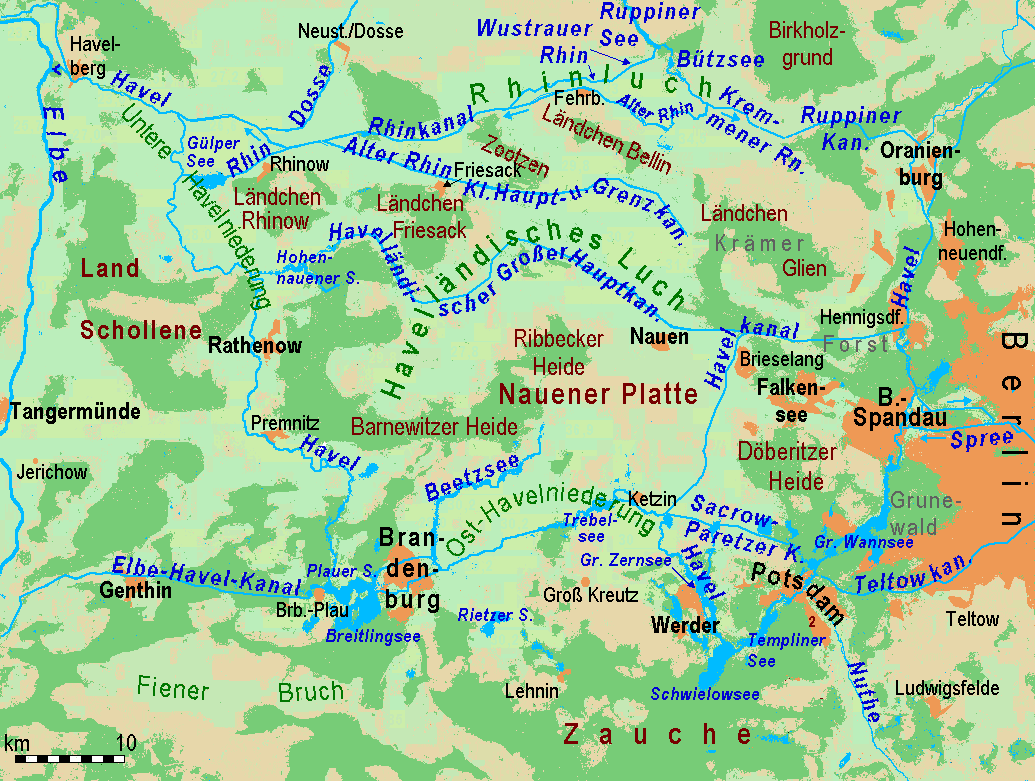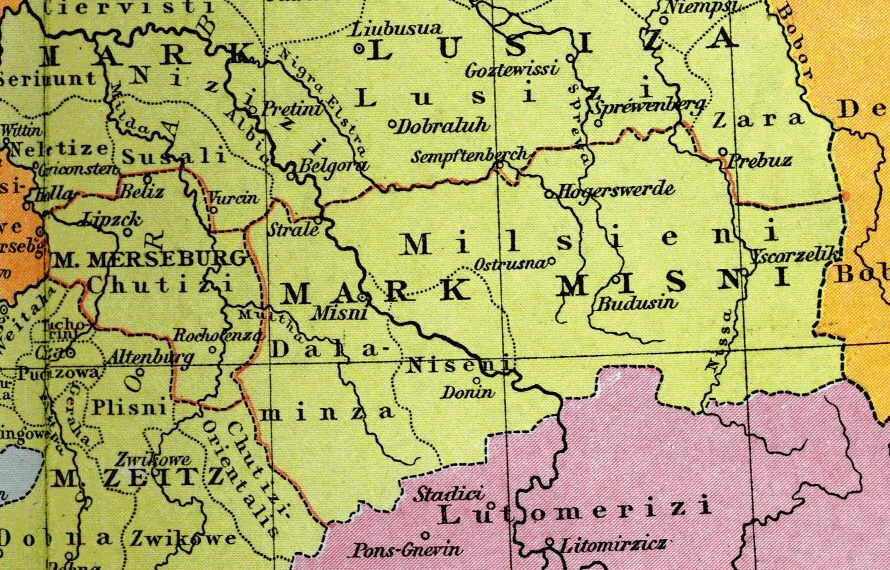|
Sorbs (tribe)
The Sorbs, also known as Serbs or White Serbs in Serbian historiography, were an Early Slavs, Early Slavic tribe settled between the Saale-Elbe valley and the Lusatian Neisse (in present-day Saxony and Thuringia). They were part of the Polabian Slavs and Wends group of Early Slavs. In the 7th century CE, the tribe joined Samo's Empire, and some Sorbs emigrated from their homeland (White Serbia) to Southeast Europe. The tribe is last mentioned in the late-10th century, but its descendants can be found among Germanized people of Saxony, among the Slavic ethnic group of the Sorbs in Lusatia, and among the Serbs of Southeastern Europe. Etymology They are mentioned between the 6th and 10th century as ''Cervetiis'' (''Servetiis''), ''gentis (S)urbiorum'', ''Suurbi'', ''Sorabi'', ''Soraborum'', ''Sorabos'', ''Surpe'', ''Sorabici'', ''Sorabiet'', ''Sarbin'', ''Swrbjn'', ''Servians'', ''Zribia'', and ''Suurbelant''. It is generally considered that their ethnonym ''*Sŕbъ'' (plur. ''*S ... [...More Info...] [...Related Items...] OR: [Wikipedia] [Google] [Baidu] [Amazon] |
Serbs
The Serbs ( sr-Cyr, Срби, Srbi, ) are a South Slavs, South Slavic ethnic group native to Southeastern Europe who share a common Serbian Cultural heritage, ancestry, Culture of Serbia, culture, History of Serbia, history, and Serbian language, language. They primarily live in Serbia, Kosovo, Bosnia and Herzegovina, Croatia, Montenegro as well as in North Macedonia, Slovenia, Germany and Austria. They also constitute a significant diaspora with several communities across Europe, the Americas and Oceania. The Serbs share many cultural traits with the rest of the peoples of Southeast Europe. They are predominantly Eastern Orthodoxy, Eastern Orthodox Christians by religion. The Serbian language, Serbian language (a standardized version of Serbo-Croatian) is official in Serbia, co-official in Kosovo and Bosnia and Herzegovina, and is spoken by the plurality in Montenegro. Ethnology The identity of Serbs is rooted in Eastern Orthodoxy and traditions. In the 19th century, the ... [...More Info...] [...Related Items...] OR: [Wikipedia] [Google] [Baidu] [Amazon] |
Bavaria
Bavaria, officially the Free State of Bavaria, is a States of Germany, state in the southeast of Germany. With an area of , it is the list of German states by area, largest German state by land area, comprising approximately 1/5 of the total land area of Germany, and with over 13.08 million inhabitants, it is the list of German states by population, second most populous German state, behind only North Rhine-Westphalia; however, due to its large land area, its population density is list of German states by population density, below the German average. Major cities include Munich (its capital and List of cities in Bavaria by population, largest city, which is also the list of cities in Germany by population, third largest city in Germany), Nuremberg, and Augsburg. The history of Bavaria includes its earliest settlement by Iron Age Celts, Celtic tribes, followed by the conquests of the Roman Empire in the 1st century BC, when the territory was incorporated into the provinces of Ra ... [...More Info...] [...Related Items...] OR: [Wikipedia] [Google] [Baidu] [Amazon] |
Havelland
Geographically, the Havelland () is the region around which the River Havel flows in a U-shape between Oranienburg to the northeast and Rhinow to the northwest. The northern boundary of the Havelland is formed by the River Rhin and the Rhin Canal. In the history of Brandenburg, the Havelland represents a historic region. In the heart of the Havelland is the Landkreis Havelland, county of the same name. In addition the Havelland includes the south of Ruppin Land with the Rhinluch, the western part of Berlin's Spandau, parts of Potsdam, the town of Brandenburg an der Havel and several villages in the county of Potsdam-Mittelmark. The Tourist Association of Havelland has chosen a rather different boundary. It covers the county of Havelland, the town of Brandenburg an der Havel and the northern part of the county of Potsdam-Mittelmark, including communities south of the Havel river, that belong to the region of Zauche. The writer Theodor Fontane described the Havelland as well as t ... [...More Info...] [...Related Items...] OR: [Wikipedia] [Google] [Baidu] [Amazon] |
Magdeburg
Magdeburg (; ) is the Capital city, capital of the Germany, German States of Germany, state Saxony-Anhalt. The city is on the Elbe river. Otto I, Holy Roman Emperor, Otto I, the first Holy Roman Emperor and founder of the Archbishopric of Magdeburg, was buried in the city's Magdeburg Cathedral, cathedral after his death. Magdeburg's version of German town law, known as Magdeburg rights, spread throughout Central Europe, Central and Eastern Europe. In the Late Middle Ages, Magdeburg was one of the largest and most prosperous German cities and a notable member of the Hanseatic League. One of the most notable people from the city was Otto von Guericke, famous for his experiments with the Magdeburg hemispheres. Magdeburg has experienced three major devastations in its history. In 1207 the first catastrophe struck the city, with a fire burning down large parts of the city, including the Magdeburg Cathedral#Previous building, Ottonian cathedral. The Catholic League (German), Catholi ... [...More Info...] [...Related Items...] OR: [Wikipedia] [Google] [Baidu] [Amazon] |
Prague-Korchak Culture
The Prague-Korchak culture was an archaeological culture attributed to the Early Slavs. The other contemporary main Early Slavic culture was the Prague-Penkovka culture situated further south, with which it makes up the "Prague-type pottery" group. The largest part of sites dates to the late 5th and early 6th century AD according to Late Roman iron fibulae. Settlements were as a rule placed at rivers, near water sources, and were typically unfortified, with 8–20 households with courtyards. Burial sites were both flat graves and barrows ( kurgans), and cremation was dominant. Slavic archaeologists including M. Kazanski identified the 6th-century Prague (Prague-Korchak) culture and Sukow-Dziedzice group as Sclaveni archaeological cultures, and the Penkovka culture (Prague-Penkovka) was identified as Antes. Michel Kazanski (2020).Archaeology of the Slavic Migrations. ''Encyclopedia of Slavic Languages and Linguistics Online''. BRILL. pp. 3–4 See also * Korchak culture * Pe ... [...More Info...] [...Related Items...] OR: [Wikipedia] [Google] [Baidu] [Amazon] |
Tornow Group
Tornow group, also known as Tornow-Klenica and Tornow-Gostyn in Poland, in archaeology refers to the Middle Slavic pottery and related strongholds of "Tornow-type" which were present in the middle of Obra (river), Obra, Oder, Spree (river), Spree but also Elbe and Saale basins from Greater Poland up to Thuringia.Roslund, 2007, p. 160, 169–171, 190, quote: "...has a distribution mainly ranging in the west to the boundary of Slavic culture on the Elbe-Saale, in the north to the Spree-Havel area, in the east into Great Poland, in the south and south-east to the Sudeten and Beskydy. The core area, however, is between the Elbe and the Warta. It is a derivation of Prague-Korchak culture, Prague-Korchak (and possibly Sukow-Dziedzice culture in Northeastern part), and dated since late 8th or early 9th century up to late 10th or early 11th century. Tornow-type pottery It is generally named after Lower Lusatian village :de:Tornow (Calau), Tornow (district of Oberspreewald-Lausitz, Brandenb ... [...More Info...] [...Related Items...] OR: [Wikipedia] [Google] [Baidu] [Amazon] |
Sukow-Dziedzice Group
The Sukow or Sukow-Dziedzice group () or Sukow-Dziedzice culture (), also known as Szeligi culture, was an archaeological culture attributed to the Early Slavs. Areal of sites lays between Elbe and Vistula rivers in Northeast Germany and North West Poland. The earliest sites usually date to the second half of 7th and mid-8th centuries. There exist different views on its origin. It has features of both Przeworsk culture and Prague-Korchak culture. In comparison to Carpathian Slavic-speaking population of Korchak-Mogilany-type some consider Sukow-Dziedzice's had different population, maybe indigenous to Poland or arrived from within Poland and Belarus or a mixture of Korchak Slavs and indigenous post-Przeworsk population. Slavic archaeologists including M. Kazanski identified the 6th-century Prague-Korchak culture and later Sukow-Dziedzice group as Sclaveni archaeological cultures, and the Penkovka culture (Prague-Penkovka) with Antes. Dating Most recent studies, based on dendro ... [...More Info...] [...Related Items...] OR: [Wikipedia] [Google] [Baidu] [Amazon] |
Milceni
The Milceni or Milzeni (; ; ) were a West Slavic tribe, who settled in the present-day Upper Lusatia region. They were gradually conquered by Germans during the 10th century. They were part of Sorbian tribes. Modern descendants of the Milceni are the Upper Sorbian-speaking Sorbs of the Free State of Saxony, Germany. Etymology Pavel Jozef Šafárik derived their name from Lithuanian language ''milżinas'' (giant, behemoth, colossus). Mikołaj Rudnicki considered it derives from personal names Milobud and Miloslav. Stanisław Urbańczyk reconstructed the ethnonym as ''Mělъčane'', meaning inhabitants of an assumed river called ''*Mělъcъ'' or ''*Mělъča'', with similar argumentation by E. Eichler and H. Walther, possibly as an older name of upper Spree. However, that hypothesis ignores consonant "z" and suffix "-jane", which would reject a form of Milčane, and suggest derivation of Milzane/Milzeni < ''*Milъt-jane'' < ''*Milit-jane'' from Latin [...More Info...] [...Related Items...] OR: [Wikipedia] [Google] [Baidu] [Amazon] |
Danube
The Danube ( ; see also #Names and etymology, other names) is the List of rivers of Europe#Longest rivers, second-longest river in Europe, after the Volga in Russia. It flows through Central and Southeastern Europe, from the Black Forest south into the Black Sea. A large and historically important river, it was once a frontier of the Roman Empire. In the 21st century, it connects ten European countries, running through their territories or marking a border. Originating in Germany, the Danube flows southeast for , passing through or bordering Austria, Slovakia, Hungary, Croatia, Serbia, Romania, Bulgaria, Moldova, and Ukraine. Among the many List of cities and towns on the river Danube, cities on the river are four national capitals: Vienna, Bratislava, Budapest, and Belgrade. Its drainage basin amounts to and extends into nine more countries. The Danube's longest headstream, the Breg (river), Breg, rises in Furtwangen im Schwarzwald, while the river carries its name from its ... [...More Info...] [...Related Items...] OR: [Wikipedia] [Google] [Baidu] [Amazon] |
Leipzig Group
The Leipzig group in archaeology refers to the Slavic pottery from the Early to High Middle Ages (from 7-8th to 13th century) in the Elbe-Saale area in today's States of Germany, state of Saxony, Saxony-Anhalt and Thuringia. It has four ceramic sub-groups or phases named after the eponymous sites of Zwenkau, Rüssen, Rötha, Groitzsch and Kohren-Sahlis, Kohren. It derives from Prague-Korchak culture. The group's area is considered to roughly correlate to the area of the Early Slavic tribe of Sorbs (tribe), Sorbs situated in Elbe-Mulde-Saale rivers valley. Research The archaeological research of early medieval ceramics in the Elbe-Saale area had begun in the second half of the 19th century. The scientific excavations were carried with greater frequency since 1920s. Liesedore Langhammer in the 1950s was first to develop a ceramic stratigraphy. It had five layers named "A-E" roughly from 7-8th to 13th century, but results were unpublished and poorly noticed. Of considerable importan ... [...More Info...] [...Related Items...] OR: [Wikipedia] [Google] [Baidu] [Amazon] |
Joachim Herrmann (archaeologist)
Joachim Herrmann (19 December 1932 – 25 February 2010) was a German historian, archaeologist, scientist, and institutional director. He was a noted scholar in East Germany (GDR) who specialized in Slavic archaeology, but with ambivalent legacy, as his career and research was politically motivated because of which he "deliberately distorted the view of history". Early life In 1932, Herrmann was born in the village of Löbnitz, Lübnitz in the district of Bad Belzig, Germany to a farming and milling family. He graduated from high school in Belzig. From 1951 to 1955, he studied history and prehistory at the Humboldt University of Berlin. He presented his doctoral dissertation in 1958 on the subject of the prehistoric and protohistoric fortifications of Greater Berlin and the district of Potsdam. His advisor was Karl-Heinz Otto. Career In 1956, Herrmann became a research assistant at the Institute for Prehistory and Early History of the German Academy of Sciences at Berlin (DAW ... [...More Info...] [...Related Items...] OR: [Wikipedia] [Google] [Baidu] [Amazon] |





